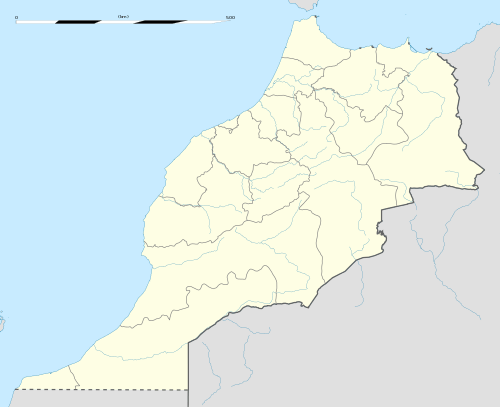Thamusida
 Shown within Morocco | |
| Location | Sidi Ayache, Kénitra Province, Rabat-Salé-Kénitra, Morocco |
|---|---|
| Coordinates | 34°20′08″N 06°29′22″W / 34.33556°N 6.48944°WCoordinates: 34°20′08″N 06°29′22″W / 34.33556°N 6.48944°W |
| Type | Romano-Berber Settlement |
Thamusida is a Roman-Berber river port and city in the northern province of Mauretania Tingitana, located near Kénitra and Mehdia, Morocco.
Characteristics
The site was excavated from 1913 by the French, then 1959 to 1962[1] and since 1998. Many items found in Thamusida are today on display at the Rabat Archaeological Museum. It occupies an area of fifteen acres. Excavations have unearthed the walls of the docks and baths. Under the Antonines, a temple was built to worship Venus.
History
The city originally was a Berber settlement, that was occupied by Romans in the first years of Augustus rule. There were a military camp and a nearby little city, until Claudius enlarged Thamusida.[2] According to historian Stefano Camporeale, the auxiliary unit that built the Roman camp in Thamusida was probably the Cohors secunda Syrorum civium Romanorum in the second half of the first century (ceramic evidence confirms this chronology): this camp (with annexed "vicus") was one of the largest camps of the whole province of Mauretania Tingitana and measured about 2 hectares. Later the settlement grew progressively, and by the end of the second century or the early third century, it was surrounded by a wall that included a total area of about 15 hectares.[3]
During the reign of Claude (41-54 AD), strengthened structures multiply in Thamusida.It probably sheltered an active port to which testify the many remains of Amphoras, and becme a point of unloading and a Roman supply centre.Under the Flaviens (69-96 AD), a Roman military garrison remained on the spot. The city gave signs of growth; a temple was raised (the Temple with embossing), as well as thermal baths and dwelling houses including one with a central court. Under Trajan (97-117 AD) or under Hadrian (117-138 AD), a new structuring of urban space seemed to take place by conferring to the city an orthogonal urbanism plan with thermal baths and a small temple dedicated to Venus-Astarte. The development and the enrichment of the city conveyed in the continuing enlarging and transformation of the river thermal baths, in the construction of new temples bordering the bank of Sebou river and in new dwellings such as the "House of pavement" which adopted the plan of the rich residences of Volubilis and Spain. Modest houses, workshops and utility buildings occupyed many districts. In addition to its commercial and industrial functions which are behind its development, the town of Thamusida was to play a significant military role. It was populated by veterans and under Marc-Aurelius (161-180 AD) was built the most imposing fortress of Tingitane so to ensure the protection of the civilian population. Under Commode (176-192 AD) or Septimius Severus (193-211 AD), an enclosure was built and which reemployed funerary steles and crushed a part of the pavement house, that indicated the fact that the work was dictated by the fear of a close or remote danger.At the IIIrd century, the city was always active as showed the extent of the river thermal baths and the density of the ceramic founds is the spot until occurred the final abandonment which took place between 274 and 285 AD, but it was not known if it was due to the departure of the Army or to a posterior cause. Scattered finds and some walls of Thamusida attested of a ephemeral occupation posterior to the date of evacuation.Ellingham, Mark
In the third century Thamusida become a mostly Christian city, with a population of nearly 7,000 inhabitants. The site was abandoned around 285 AD, when Diocletian moved the Roman limes of Mauretania Tingitana to the north, near Lixus. There were some inhabitants -according to recent archeological discoveries[4]- in Thamusida for another century after the Roman abandonment. But with the Vandal invasion the city disappeared around 425 AD.[5]
References
- ↑ Fasti archaeologici, Volume 17,Sansoni Editore., 1962
- ↑ French article on Thamusida
- ↑ Camporeale: "Military building techniques in Mauretania Tingitana: the use of mortar and rubble at Thamusida" p. 169-171
- ↑ Military building techniques in Thamusida
- ↑ Thamusida (in French)
Bibliography
- Camporeale, Stefano. Military building techniques in Mauretania Tingitana: the use of mortar and rubble at Thamusida. Comm. Hum. Litt. Vol. 128 University of Siena. Siena, 2011
- Gliozzo, Elisabetta, Isabella Turbanti Memmi, Aomar Akerraz and Emanuele Papi (edd.), Sidi Alli ben Ahmed - Thamusida 2. L'archéométrie. L'archeometria (Roma, Edizioni Quasar, 2009).
- J. P. Callu, J. P. Morel, R. Rebuffat, G Hallier et J. Marion, "Thamusida", Mélanges d'archéologie et d'histoire (École Française de Rome), vol. 43, no 1-2, 1966
See also
- Iulia Valentia Banasa
- Iulia Constantia Zilil
- Iulia Campestris Babba
- Tamuda
- Tingis
- Lixus
- Sala Colonia
- Volubilis
- Roman 'Coloniae' in Berber Africa
- Christian Berbers
- Mauretania Tingitana
%2C_Algeria_04966r.jpg)